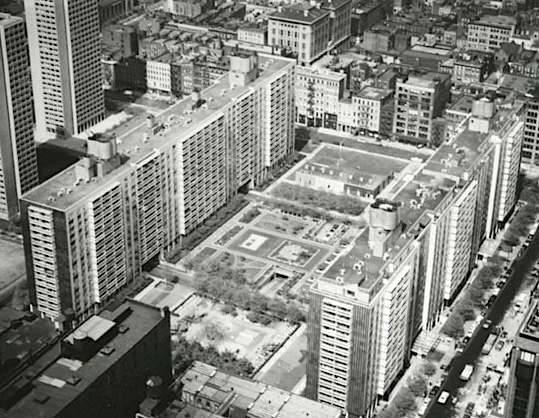Unloved when it opened in 1958, a Greenwich Village “superblock” apartment complex is finally embraced
The first announcement about the monstrous apartment “superblocks” came from the New York Times in July 1957. “Six-Block Project to Rise in Village,” the headline read.

The description that followed sounded like a housing plan better suited for an outer borough, not the historic loveliness and charm of low-rise Greenwich Village.
“Three buildings of 17 stories each will provide a total of 2,004 apartments in the rectangle bounded by West Third Street, Mercer Street, West Houston Street, and West Broadway (which will be widened to 120 feet and renamed Fifth Avenue South),” wrote the Times.

“Each building will be nearly three-blocks long, faced with glazed brick in wide vertical panels of blue, yellow, lavander, and other colors.” The buildings would frame an underground garage, per the Times, and feature a park and play areas. A two-room unit would run $120 per month.
Ultimately, four buildings forming two “superblocks” spanning Mercer Street to LaGuardia Place and West Third to Bleecker Street were constructed.
The land was acquired (and then sold to developers after dozens of tenements and manufacturing buildings were razed) by Parks Commissioner Robert Moses under a slum clearance effort, according to a 2012 Village Preservation blog post.

The renaming of West Broadway never materialized. But the behemoth christened Washington Square Village opened to tenants in 1958—a for-profit venture aimed at middle class residents.
Unsurprisingly, this unglamorous project was met with jeers.
“The mellow old landmarks of Greenwich Village are rapidly disappearing beneath modern glass monuments to the bourgeois respectability against which the Bohemians revolted forty years ago,” wrote one critic in 1957 in the New York Times.”This so-called Washington Square Village will hardly resemble the Washington Square of Henry James’ day or the Greenwich Village of Maxwell Bodenheim’s.”
A group called the Greenwich Village Association charged that apartment projects like Washington Square Village, “’failed to meet basic community needs’ and brought into the area ‘large numbers of people with no reason for neighborhood pride,'” the Times reported in April 1959.

And in a 1958 Times article about the demise of the Village, another writer had this to say: “One block south of the Square, these modern towers—they are striped blue, pumpkin, yellow and white—stand like a Leger painting next to a Victorian etching.”
The critics might have been pleased when Washington Square Village’s developers became insolvent in 1963. New York University swooped in to purchase the complex for $25 million, announcing that current leaseholders could remain but as vacancies opened up, professors would take over the apartments.
As time passed, the Village adjusted to Washington Square Village. Sasaki Garden, designed by Modernist landscape architect Hideo Sasaki, provided a public oasis of trees amid pathways and benches. A playground gave resident kids a place to run. The colorful glazed bricks made a nice contrast to the boring white-brick postwar apartment house.

And after all, Washington Square Village provided modern, doorman-attended apartments for people and families (mostly NYU-affiliated as time went on) who would have a hard time finding comparable and affordable housing in the increasingly posh Village.
It may have taken half a century, but in 2011, Washington Square Village finally got its due. That year, the New York State Historic Preservation Office agreed with the Landmarks Preservation Commission’s earlier finding that the complex should be named to the National Register of Historic Places.
Washington Square Village was deemed to be “a superblock complex of two residential towers, elevated landscaped plaza, commercial strip, and below-grade parking” and “an impressive example of postwar urban renewal planning and design,” the Office wrote, via a 2016 Village Preservation post.

The historic eligibility just goes to show that if a derided building waits it out long enough, the neighborhood just might come around and embrace it.
[Top image: Wikipedia; second image: William Eppes Collection, GVSHP; third photo: Robert Otter via Wikipedia]



